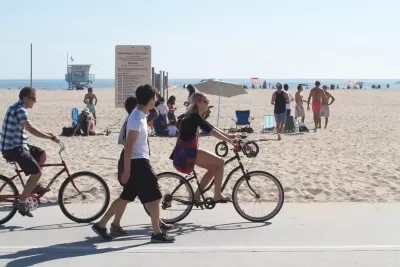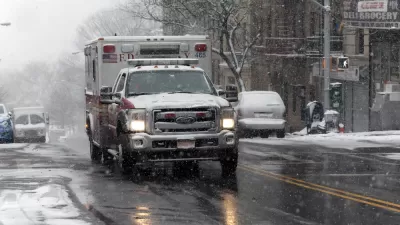The lead editorial in the December issue of American Journal of Public Health provides the introduction for two research papers on the relationship between bicycling safety and infrastructure expansion in Boston and Vision Zero in U.S. and Sweden.

American cities that have adopted Vision Zero goals for walking and biking have their work cut out. Compared to other advanced nations, it's undeniable that cycling in the United States is less safe.
According to a study last year by the Centers for Disease Control and Prevention, deaths and injuries, associated with an increase in bicycling activity, have risen among older Americans, just as a reduction in juvenile deaths is related to a reduction in that group's cycling.
What's more, some studies have inferred blame lies with cyclists themselves, e.g., cyclists failing to use bike lights and helmets.
Thus, it's refreshing to read what urban planners have to report on this critical topic in next month's issue of the American Journal of Public Health. As many cyclists and planners know, while the use of bike lights, helmets, and reflective clothing is important, it is the design of cycling facilities that is paramount.
"Traffic safety experts now use the term 'crashes' instead of 'accidents' to emphasize that the design of the transportation system contributes to most traffic fatalities and injuries," write John Pucher, Professor Emeritus, Urban Planning, Rutgers University and Ralph Buehler, Professor of Urban Affairs & Planning, Virginia Tech. The two present hard data that may lead some ardent cyclists to consider migrating abroad.
Controlling for exposure levels, cyclist fatalities in 2010 per 100 million kilometers cycled were 4.7 in the United States versus 1.0 in the Netherlands, 1.1 in Denmark, and 1.3 in Germany.1
The editorial introduces two full-length research articles in the Dec 2016 issue of AJPH focusing on cycling safety that are fully accessible:
- AJPH Research: Bicycle Use and Cyclist Safety Following Boston’s Bicycle Infrastructure Expansion, 2009–2012, December 2016
- AJPH Research: Vision Zero in the United States Versus Sweden: Infrastructure Improvement for Cycling Safety, December 2016
Pucher and Buehler present detailed data on trends in cycling safety for 10 cities, looking at the relationship between the increase in bike lane miles, bicycle trips, crashes, and fatalities and injuries between 2000 and 2015.
TABLE 1— Better Bicycle Infrastructure, Improved Cyclist Safety, and Increased Cycling
| City | Years | Growth in Bikeway Network,a % | Growth in Bicycle Trips, % | Change in Crashes per 100 000 Trips, % | Change in Fatalities and Severe Injuries per 100 000 Trips,% |
| Portland, OR | 2000–2015 | 53 | 391 | −62 | −72 |
| Washington, DC | 2000–2015 | 101 | 384 | −46 | −50 |
| New York, NY | 2000–2015 | 381 | 207 | NA | −72 |
| Minneapolis, MN | 2000–2015 | 113 | 203 | −75 | −79 |
| San Francisco, CA | 2000–2015 | 172 | 167 | −36 | NA |
| Cambridge, MA | 2000–2015 | 27 | 134 | −57 | NA |
| Chicago, IL | 2005–2015 | 135 | 167 | −54 | −60 |
| Seattle, WA | 2005–2015 | 236 | 123 | −25 | −53 |
| Los Angeles, CA | 2005–2015 | 130 | 114 | NA | −43 |
| Philadelphia, PA | 2008–2015 | 17 | 51 | NA |
Courtesy of American Journal of Public Health
Like the National Safety Council, research is based on data provided by the Centers for Disease Control and Prevention, particularly from their injury statistics website, WISQARS, which indicates that in 2014, there were 902 cyclist fatalities and 35 206 serious cyclist injuries (requiring hospitalization).
Planetizen also posts traffic fatality reports from the National Highway Traffic Safety Administration (NHTSA) which uses the Fatality Analysis Reporting System (FARS) run by the U.S. Department of Transportation.
Hat tip to John Holtzclaw
Correspondent's notes on related Planetizen posts:
- Studies on bicycle injuries and fatalities: Journal of the American Medical Association, 1998-2013 (September 2015)
- Bicycle fatalities, 1975–2012, U.S. Centers for Disease Control and Prevention (August 2015)
- Two posts on a controversial GHSA bicycle fatalities report, 2010-2012 (November 2014 and October 2014)
FULL STORY: Safer Cycling Through Improved Infrastructure

Pennsylvania Mall Conversion Bill Passes House
If passed, the bill would promote the adaptive reuse of defunct commercial buildings.

Planning for Accessibility: Proximity is More Important than Mobility
Accessibility-based planning minimizes the distance that people must travel to reach desired services and activities. Measured this way, increased density can provide more total benefits than increased speeds.

World's Largest Wildlife Overpass In the Works in Los Angeles County
Caltrans will soon close half of the 101 Freeway in order to continue construction of the Wallis Annenberg Wildlife Crossing near Agoura Hills in Los Angeles County.

Maine Approves Rent Relief Program
Legislators hope the assistance program will help struggling low-income households avoid eviction.

How Transit Architecture Impacts Real and Perceived Safety
More than a third of Americans believe major transit systems are too unsafe to ride. The built environment can change that.

New York Passes Housing Package Focused on New Development and Adaptive Reuse
The FY 2025 budget includes a new tax incentive, funding for affordable housing on state land, and support for adaptive reuse and ADUs.
City of Costa Mesa
Licking County
Barrett Planning Group LLC
HUD's Office of Policy Development and Research
Mpact Transit + Community
HUD's Office of Policy Development and Research
Tufts University, Department of Urban and Environmental Policy & Planning
City of Universal City TX
ULI Northwest Arkansas
Urban Design for Planners 1: Software Tools
This six-course series explores essential urban design concepts using open source software and equips planners with the tools they need to participate fully in the urban design process.
Planning for Universal Design
Learn the tools for implementing Universal Design in planning regulations.

























